By Savannah Campbell
Written: 23 May 2017
On the APEX team’s second day in Cartagena, we made our first visit to one of our host institutions: Archivo Municipal Cartagena. At the archive, some of the APEX participants and organizers will be working with a collection of videotapes from the local public television station Telecartagena. Archivo Municipal is a general archive with collections of books, manuscripts, photographs, film, and other materials. The collection of videotapes donated by Telecartagena is the first magnetic media collection that the archive has acquired.
Our first order of business at Archivo Municipal was attending a press conference in promotion of APEX Cartagena and the audiovisual preservation workshops we will be leading at the archive over the course of the next two weeks. To kick of the press conference, two Cartagena city councilors (Francisco Aznar and David Martínez Noguera) introduced the APEX program, the preservation projects we will be working on in Cartagena, and the workshops we will be leading. Then, APEX founder Mona Jimenez thanked all of the APEX Cartagena partner institutions, both in the U.S. and in Spain, and discussed the history of APEX and its relationship to the NYU Moving Image Archiving and Preservation program. She emphasized the need for international collaboration in order for preservationists to learn from one another and exchange practices, as well as the importance of bringing students and faculty together to work on collections of endangered media around the world. Finally, one of our partners Salvi Vivancos spoke of his project at Memorias Celuloides and creating a database for home movies, as well as the need for archivists and preservationists to collaborate in order to make collections accessible. APEX advisor Juana Suárez translated the press conference for both the English and Spanish speakers on the panel and in attendance.
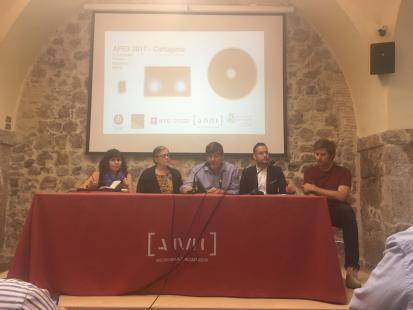
Pictured from left to right: Juana Suárez, Mona Jimenez, Francisco Aznar, David Martínez Noguera, Salvi Vivancos
A recording of the press conference can be viewed online here: http://www.cartagena.es/detalle_noticias.asp?id=43742&pagina=1&c=&t=&d=&h=
Following the press conference, the entire APEX Cartagena team received a tour of Archivo Municipal and was shown the tapes from the Telecartagena collection. One of the video team’s main goals for our first day at the archive was to gain a better understanding of the videotape collection and the archive’s current preservation workflow for the collection. Members of the video team (including myself, Pamela Vizner, and Mona Jimenez) led a discussion with several of the archivists at Archivo Municipal. All APEX participants (not just those working on the video project) attended this meeting and were able to see what kinds of work the video team would be performing during the trip.

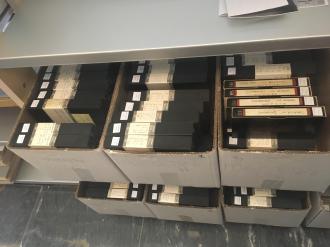
Some of the U-Matic and VHS tapes in the Telecartagena collection
We learned from Archivo Municipal archivists and technicians Rafael, Antonio, and Raquel that the Telecartagena collection is comprised of 8,000 tapes and discs of the following formats: U-Matic, Betacam, VHS, DVCAM, and DVD. The U-Matic, Betacam, and DVCAM tapes primarily contain raw camera footage, while the VHS and DVDs are mostly edited broadcast transmissions. In discussion with the archivists, Mona Jimenez emphasized the importance of knowing Telecartagena’s production process and how the tapes were created, and making preservation decisions based on that information. In addition to the media itself, Telecartagena also donated their paper records for all of the tapes. While the tapes themselves seemed to contain little identifying information beyond an identifier and a title, the paper records included entire shot lists for the material on the tapes. Archivo Municipal has already begun processing the collection, which includes assigning each tape a unique identifier, rehousing the tapes in archival boxes, and creating catalog records. Some of the processed tapes have already been sent to vendors for digitization. Thus far, the archive has prioritized the 900 U-Matic tapes in the collection for processing and digitization, as the U-Matics represent the oldest material in the collection.
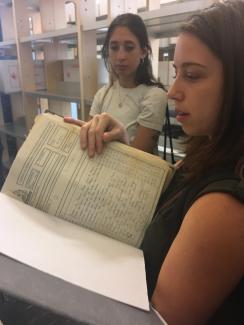
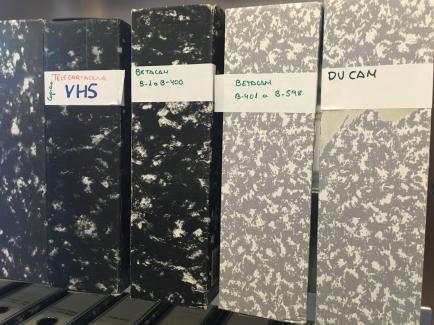
Detailed paper records of the Telecartagena collection, all housed in binders corresponding to tape format and date of production.
We also discussed what projects the APEX video team could perform that would be most beneficial to Archivo Municpal. Some potential activities for our two weeks at the archive include examining their existing inventory and suggesting what metadata fields they can add to it, discussing best practices for digitization workflows (including choosing sustainable digital file formats to migrate the magnetic media to), as well as demonstrating a video digitization station.
This year’s APEX also marks the inaugural trip of APEX’s traveling video digitization kit. The video kit was designed by myself, Pamela Vizner, and Jim Lindner, with input from past APEX participants Jonathan Farbowitz and Eddy Colloton. It includes all of the pieces of equipment necessary to create a minimal video digitization station, with the exception of a playback deck and a monitor. This video kit will be taken on future APEX trips and will be used to demonstrate the process of migrating video tape content to digital files.
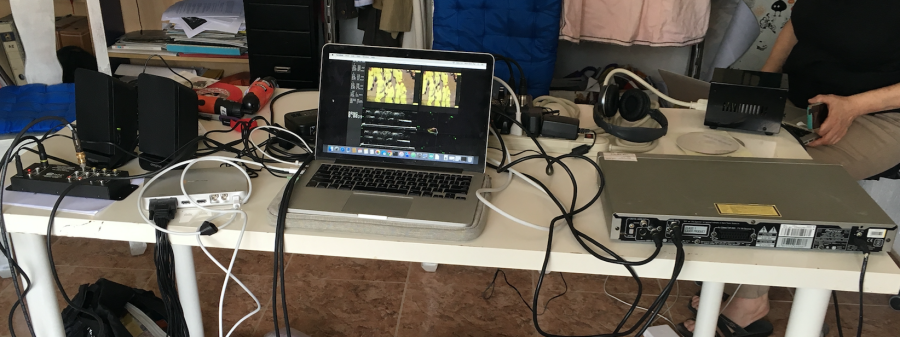
The traveling APEX video kit
On day one of APEX Cartagena, I set up the video digitization equipment with my video project teammates Pamela Vizner, Nerea Moreno Felipe, and Jacob Zaborowski. Together, we tested all of the equipment and explained the signal paths for the video and audio streams as they traveled from the source deck (using a DVD player in this test setup) to the capture card and the laptop (running the free, open-source video digitization software vrecord).
We plan on bringing the video kit to Archivo Municipal and demonstrating the digitization station for them. The video kit will also be demonstrated at a video preservation workshop that will be held next week and is open to the general public.